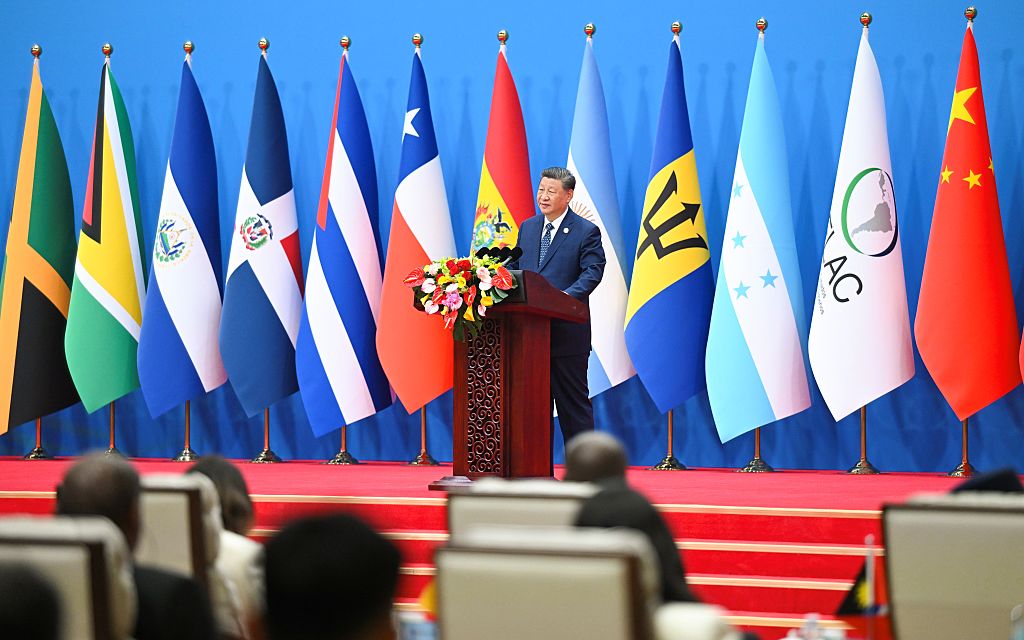In early May, during the opening ceremony of the China-Community of Latin American and Caribbean States (CELAC) Forum, President Xi Jinping unveiled a five-pillar plan that will guide China’s engagement with 33 countries in the region over the next three years. The roadmap institutionalizes China’s presence in the Western Hemisphere, raising significant concerns for the U.S. and most nations involved in this new strategy.
The new framework, formalized in the 2025–2027 China-CELAC Joint Action Plan, is based on nearly intuitive premises—Solidarity, Development, Civilization, Peace, and People-to-People Connectivity—reflecting China’s evolving toolkit for influence in the region. However, beneath the language of mutual respect and cooperation lies the most consequential goal: to position China as a dominant actor in the Americas.
This plan represents China’s most significant effort to date to bolster its influence in the Americas, revealing the contours of Beijing’s long-term ambitions in the region. It raises urgent questions about the future of sovereignty and strategic alignment for Latin American and Caribbean countries, as well as national security for the U.S.
As the U.S. cuts aid to Latin America and the Caribbean (LAC), China appears to be gaining momentum, having already supplanted the U.S. as South America’s top trading partner in recent years. After China joined the WTO in 2001, trade with the region grew annually by 31% for eight years. Last year, this trade reached $518 billion, and economists believe it could exceed $700 billion by 2035.
However, China’s government investment has begun to decline. Outlays from state-owned financial institutions have dried up, and it is now Chinese companies that are driving investment in carefully selected sectors of strategic importance to Beijing, including technology, telecommunications, green energy, critical minerals, and electric vehicles. China’s new framework rolled out for CELAC reflects this shift toward specific strategic economic priorities, as well as a significant expansion of its political and social ties with the region.
New and stronger ties
The Solidarity pillar focuses on cementing political ties across ideological lines. The most telling initiative is China’s pledge to invite 300 political party officials from CELAC countries to Beijing annually—900 over three years. This effort is not simply about diplomacy; it’s about hedging against electoral volatility.
As left-leaning governments in Mexico, Brazil, Colombia, and Chile tilt more favorably toward Beijing, China appears keenly aware that leadership in the region can change abruptly. Presidential or parliamentary elections loom in Chile, Bolivia, Jamaica, and Honduras in 2025; in Brazil, Peru, Colombia, and Costa Rica in 2026; in Argentina and Taiwan-allied Guatemala in 2027; and in Paraguay, Taiwan’s other principal regional ally, in 2028. By cultivating relationships with mid- and upper-tier party leaders, including prospective presidential or prime ministerial contenders, China is building political resilience into its LAC strategy.
China has developed particularly deep ties in Brazil, Peru and Chile. China is the largest trading partner for all three, and they have received the lion’s share of Chinese investment in the last decade as key players in sectors of special interest to Chinese companies: agriculture, 5G technology, critical minerals, and electric vehicles.
Under the Development pillar, aligned with China’s Global Development Initiative, Beijing is offering a $9 billion credit line to support regional infrastructure, poverty reduction, and digital transformation. Also on offer: 300 technical training opportunities and 300 “small but beautiful” local assistance projects.
The plan explicitly promotes financial instruments like “Panda Bonds,” yuan-denominated debt vehicles that expand the use of China’s currency in cross-border transactions. So far, Argentina, Brazil and Bolivia can officially settle trade in Chinese yuan, and Argentina has long held a $5 billion currency swap to shore up its dwindling foreign reserves. The plan also calls for the creation of an equity investment cooperation fund and promotes bilateral dispute resolution mechanisms—implicitly challenging multilateral financial norms.
One particularly notable concept is the construction of “friendly ports.” The term appears designed to downplay mounting scrutiny over China’s apparent control of key maritime infrastructure in the region, such as Chancay in Peru or the port terminals around the Panama Canal. These port holdings, particularly when paired with language around dual-use cooperation in transportation, raise red flags for analysts who track China’s potential to leverage commercial assets for military or intelligence purposes.
The development agenda also includes expanded cooperation in next-generation technology: big data, cloud computing, the Internet of Things, smart cities, artificial intelligence, and radio spectrum management. As Washington and Beijing compete globally in emerging tech, LAC is fast becoming a key arena for digital infrastructure and regulatory alignment.
China’s expanding security footprint
The Peace pillar, framed under the Global Security Initiative, delves into cybersecurity, transnational crime, and public safety. The plan proposes the creation of a liaison mechanism between national Computer Emergency Response Teams (CERTs)—a seemingly technical measure that, in practice, could give Chinese cybersecurity authorities privileged access to digital threat-sharing networks in the Americas. This is also interesting given that China-based actors have often been culprits of cyber intrusions across the region. In 2021, for instance, the cyber-espionage group Nickel targeted 16 LAC governments.
The Action Plan acknowledges—albeit obliquely—the rise of Chinese-linked criminal syndicates in Latin America. It proposes police training and operational coordination to combat money laundering, human trafficking, illegal mining, wildlife smuggling, and narcotics trafficking. In recent years, Chinese criminal networks have engaged in all of these activities in the region and elsewhere around the world. By mentioning these activities specifically, the Chinese government is sending a message that it is willing to assist LAC countries in addressing this issue through increased law enforcement cooperation.
Other components of this pillar are equally revealing. The plan calls for enhanced cooperation in aerospace, including a Beidou Cooperation Forum and the establishment of a Beidou Application Development Center. Beidou, China’s satellite navigation system, is designed to compete with GPS and offers Beijing an opportunity to embed its technological standards into regional navigation and communications infrastructure.
The plan also reaffirms China’s interest in Antarctica, highlighting research cooperation and the exchange of scientists. This aligns with China’s growing strategic presence near the Strait of Magellan—one of the world’s most critical maritime chokepoints—and reflects broader ambitions in polar governance and space-based observation.
Climate change features prominently as well. From launching a “Zero-Carbon Island” initiative for Caribbean nations to establishing a China-Caribbean Development Center, Beijing is positioning itself as a more reliable climate partner—especially as the U.S. faces growing criticism over its wavering climate commitments and recent institutional rollbacks, including the dismantling of USAID.
Projecting values, not just power
The Civilization pillar underpins China’s Global Civilization Initiative and reinforces its soft power strategy. It encompasses everything from cultural festivals and film exchanges to tourism cooperation and museum digitization. The plan proposes a Civilization Dialogue Conference—echoing a suggestion made by Colombian President Gustavo Petro—and further integrates Confucius Institutes and Classrooms into regional education systems.
China will offer 500 international Chinese teaching scholarships, 1,000 “Chinese Bridge” exchange slots, and 30,000 Chinese textbooks to CELAC member states. These measures aim to spread China-friendly narratives in Latin American educational and cultural spaces. It is a reminder that China’s ideological engagement in the region is not passive; it is curated, strategic, and increasingly professionalized to boost China’s discourse power.
The final pillar—People-to-People Connectivity—brings China’s outreach down to the municipal and community level. Through local government forums, friendship associations, tourism dialogues, and sports exchanges, Beijing is building a bottom-up architecture of influence. It plans to provide 500 training opportunities for scholars and journalists from CELAC countries, sponsor a Chinese film and television exhibition, and translate 10 new TV series annually into Spanish and Portuguese.
These initiatives are not just cultural outreach. They are part of a broader method to shape public opinion and discourse across all facets of society—from local governments and universities to media outlets and sporting organizations.
The sovereignty and security dilemma
Together, these five pillars constitute a sophisticated, multidimensional strategy. While couched in the language of partnership, the 2025–2027 Action Plan raises important questions about autonomy, resilience, and dependency.
For LAC countries, the allure of Chinese investment and infrastructure is undeniable. However, the trade-offs are becoming increasingly difficult to ignore: strategic infrastructure with unclear end uses; digital platforms potentially linked to Chinese intelligence; and a steady drumbeat of political, educational, and cultural programming that privileges Beijing’s worldview.
For the U.S., the implications are stark. The China-CELAC Action Plan is a strategic roadmap designed to embed China across the entire spectrum of governance, economics, and society in the Western Hemisphere. It institutionalizes China’s presence in a region long considered within the U.S.’s strategic orbit—and it does so in ways that are difficult to counter with episodic aid or rhetorical support.
If the U.S. and its allies hope to remain credible partners in the Americas, they must offer clear alternatives—on infrastructure, technology, education, and climate—that match the scope and staying power of China’s vision. Otherwise, Washington risks ceding the initiative to China not just for the next three years, but for many years to come.






